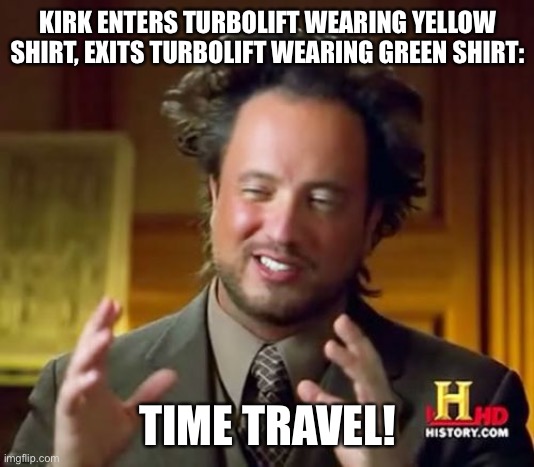As mentioned plenty of times over the years, the Kelvin Timeline seem to sport a lot of differences from the prime one already before Nero’s arrival. A few years ago Simon Pegg commented that the changes actually expanded in the past as well, in what he called the “ripples effect”, so the further in the past you got the less the differences between the two timelines would be.
This is a theory i came up some time ago to explain how such a ripples effect would work in practice.
Thing is: we tend to consider time travel too linearly while in fact
it’s full of intermingled events. The Kelvin being destroyed meant that
what we see in TOS, TNG and so on didn’t happen or happened differently,
but therefore there are /more time travel events/ that we see in those
series (and others we don’t see, presumably) that don’t happen or happen
differently as well, having different consequences on the past than in
the original timeline, leaving the abramsverse different than we expect
even before Nero’s incursion.
Let’s make a couple of examples…
If Star Trek IV doesn’t happen, Scotty doesn’t reveal the formula for
transparent aluminum to Dr. Nichols. Instead, transparent aluminum is
discovered by another person a few years down the road, who follows a
completely different marketing strategy for the new material, leading to
a much more widespread use. The new material is used extensively in
construction, leading to the giant skyscrapers we see in the new
timeline, and when Starfleet starts building their fleet they use it
much more than in the original timeline, adding windows, most notably
the one on the bridges. Also, the experience Earth engineers had in
building giant structures on the surface makes it thinkable to build
even starships on the ground, at least occasionally.
In the same movie, Gillian Taylor is removed from the 20th century. If
this doesn’t happen, she might eventually have children there with
someone and one of her descendants could be a strong detractor of the
Constitution project, leading to the Enterprise being built later than
in the original timeline.
As you can see it’s possible to justify virtually any inconsistency this
way, from the looks of the uniforms to Checkov’s age.
This theory also kinda invalidates the idea that Enterprise happened in
the Kelvinverse /as we saw it/. If we follow it it’s implied that while
Enterprise happened mostly as we know it would have at very least looked
different, perhaps with a bridge window and so on.
The theory also has brainwrecking consequences on time travel as we know
it, but those can be explained as well. For examples: does my first
example mean that Scotty came back to the twenty-third century
discovering that bridge windows aren’t a thing while they were before he
changed the past? This can be explained with the change always having
been part of the timeline, the old good predestination paradox.
The single, most glaring, problem with the Kelvin timeline becomes how
can it exist without overwriting the original one, as per official
statements. This is something my theory can’t address, but I guess it
could be explained in other ways
This is a theory i came up some time ago to explain how such a ripples effect would work in practice.
Thing is: we tend to consider time travel too linearly while in fact
it’s full of intermingled events. The Kelvin being destroyed meant that
what we see in TOS, TNG and so on didn’t happen or happened differently,
but therefore there are /more time travel events/ that we see in those
series (and others we don’t see, presumably) that don’t happen or happen
differently as well, having different consequences on the past than in
the original timeline, leaving the abramsverse different than we expect
even before Nero’s incursion.
Let’s make a couple of examples…
If Star Trek IV doesn’t happen, Scotty doesn’t reveal the formula for
transparent aluminum to Dr. Nichols. Instead, transparent aluminum is
discovered by another person a few years down the road, who follows a
completely different marketing strategy for the new material, leading to
a much more widespread use. The new material is used extensively in
construction, leading to the giant skyscrapers we see in the new
timeline, and when Starfleet starts building their fleet they use it
much more than in the original timeline, adding windows, most notably
the one on the bridges. Also, the experience Earth engineers had in
building giant structures on the surface makes it thinkable to build
even starships on the ground, at least occasionally.
In the same movie, Gillian Taylor is removed from the 20th century. If
this doesn’t happen, she might eventually have children there with
someone and one of her descendants could be a strong detractor of the
Constitution project, leading to the Enterprise being built later than
in the original timeline.
As you can see it’s possible to justify virtually any inconsistency this
way, from the looks of the uniforms to Checkov’s age.
This theory also kinda invalidates the idea that Enterprise happened in
the Kelvinverse /as we saw it/. If we follow it it’s implied that while
Enterprise happened mostly as we know it would have at very least looked
different, perhaps with a bridge window and so on.
The theory also has brainwrecking consequences on time travel as we know
it, but those can be explained as well. For examples: does my first
example mean that Scotty came back to the twenty-third century
discovering that bridge windows aren’t a thing while they were before he
changed the past? This can be explained with the change always having
been part of the timeline, the old good predestination paradox.
The single, most glaring, problem with the Kelvin timeline becomes how
can it exist without overwriting the original one, as per official
statements. This is something my theory can’t address, but I guess it
could be explained in other ways


